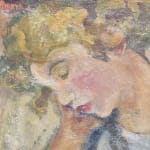



Elisabeth Fuss-Amoré 1879-1959
Further images
Colette’s novels explored terrain largely untouched in twentieth century Europe. Themes of homosexuality, abortion, and drug use emboldened her novels which were initially published under her husband’s name. She had numerous affairs with women throughout her three marriages, most notably with actress Mathilde de Morny. The two shared a kiss on stage that incited a violent riot. After her first divorce, she lost access to her book profits. Writing under her own name, she crafted stories of independent women charged with self-discovery and love. She would often interweave her own life into the blood of her characters. Her work as a dance hall performer was as transgressive as her written work, at times appearing nude on stage.
Fuss-Amore’s portrait of Colette captures her in the midst of quiet reverie. A slightly flushed cheek rests upon her hand, while the other gently touches her arm. Fuss-Amore’s painterly brushstrokes and delicate treatment of the subject transpose Colette into a moment of tender repose and self-assuredness. The viewer nearly intrudes on this intimate moment and catches Collette afloat in the ranges of her own imagination.
Colette did not participate in any feminist political activity in her lifetime, and vocally opposed suffragettes, much to the delight of her contemporaries. Yet, she will become the most cited woman in Simone de Beauvoir’s The Second Sex (with 21 mentions) when second-wave feminism rises in America.
She was not a woman easily categorized, both in her politics or her art. She evades swift generalization that would only sanitize her legacy and art. All of this made her a coveted portrait model, as many artists were eager to capture her daring spirit. Fuss-Amore’s depiction of Colette explores the author’s inner sensibility which continues to enchant and provoke.



